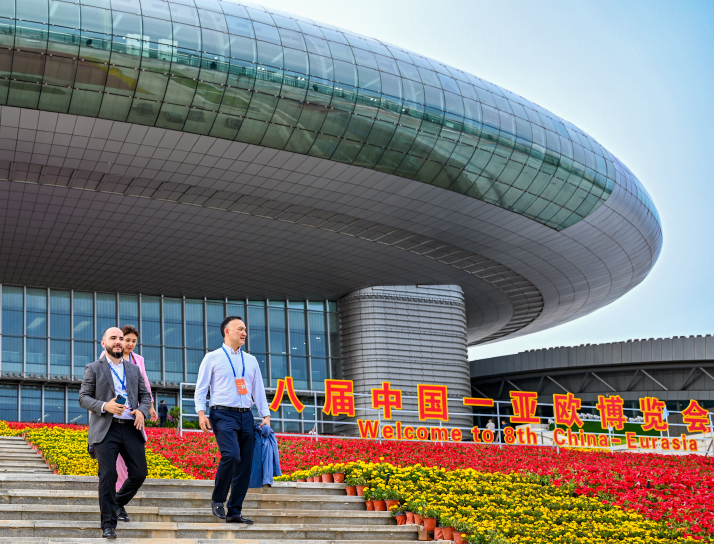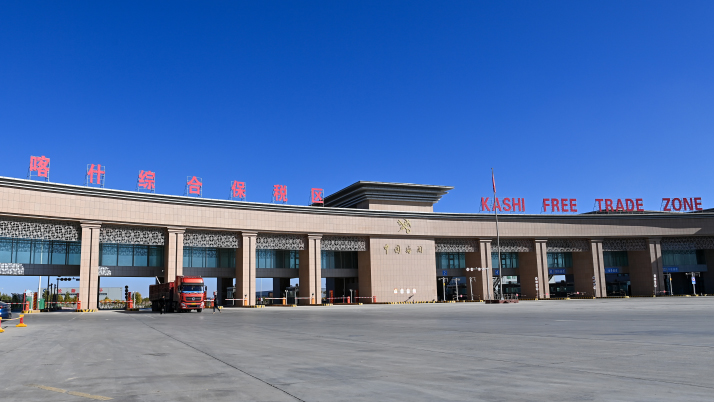| Xinjiang Today |
| Charting a course for progress | |
|
|
 Participants at the Eighth China-Eurasia Expo in Urumqi on June 26, 2024 (XINHUA)
U.S. electric vehicle (EV) manufacturer Tesla is targeting the 2025 (China) Eurasia Commodity and Trade Expo to be held in Urumqi from June 26-30, as a key opportunity for market expansion. The EV maker will showcase its full product line during its debut at the event. In today's increasingly competitive new-energy vehicle market, this is a clear demonstration of Tesla's pursuit for new growth opportunities. Indicating the region's growing importance, Tesla's monthly sales in Xinjiang surged over 300 percent year on year in April. The company is also investing heavily in Supercharger infrastructure, with stations placed approximately every 10 minutes' drive within Urumqi. "The (China) Eurasia Commodity and Trade Expo is a vital platform for opening up and cooperation," Su Xiaoxia, a Tesla employee in Xinjiang, told Xinjiang Daily newspaper. "We hope to further expand our market presence through participation in the Expo." To be held at the Xinjiang International Convention and Exhibition Center, this year's Expo boasts a record-breaking 100,000-square-meter exhibition area. Institutions and enterprises from over 20 countries and regions across Asia, Europe, America and Africa are participating, an example of Xinjiang's increasing international connectivity. The Expo demonstrates Xinjiang's commitment to expanding high-level opening up and sharing development opportunities with global partners at a local level. It not only creates favorable conditions for Chinese companies to "go global" and explore new markets but also provides international firms with a convenient gateway to the vast Chinese market. Unique advantages Xinjiang is the largest provincial-level region in China, covering approximately one sixth of the country's total land area. It is also the provincial-level region in China with the most international borders, connecting the country to Mongolia, Russia, Kazakhstan, Kyrgyzstan, Tajikistan, Afghanistan, Pakistan and India. The region's geographical position has given it a crucial role in foreign trade. Historically, Xinjiang has served as a vital passage along the Silk Road, facilitating close and frequent economic and cultural exchanges with Central Asia, West Asia, South Asia and Europe. Ancient caravans transported exquisite Chinese goods, such as silk, tea and porcelain, to these regions, while bringing back spices, jewelry and diverse cultural influences. This made Xinjiang an important link connecting Eastern and Western civilizations. Since the launch of the Belt and Road Initiative (BRI) in 2013, Xinjiang has emerged as a shining pearl on the new Silk Road. Located deep within Eurasia, Xinjiang has leveraged its unique geographical advantages to become a key component of China's westward opening-up strategy, transforming itself into a pivotal bridgehead. The BRI is a China-proposed initiative to boost connectivity along and beyond the ancient Silk Road routes. President Xi Jinping emphasized the need to leverage Xinjiang's unique regional advantages when visiting the region in August 2023. He has encouraged the region to actively serve and integrate into the new development pattern, advance opening up based on the region's distinctive conditions, and accelerate the construction of the core area of the Silk Road Economic Belt, thereby becoming a bridgehead for westward opening up. The Silk Road Economic Belt, which is part of the BRI, aims to transform Eurasia through infrastructure development, improved connectivity and strengthened economic cooperation. The economic belt is considered the longest economic corridor in the world—and potentially the most dynamic one—connecting the Asia-Pacific region in the East with developed European economies in the West. Xinjiang has numerous traditional trade routes and land ports. The State Council, the highest state administrative organ, has approved 18 international land ports in Xinjiang. The region is also continuously optimizing port infrastructure and customs clearance procedures, offering streamlined services. Now customs clearance at Xinjiang's ports is renowned for its speed and efficiency. On May 23, at the 2025 Media Cooperation Forum of SCO Countries, held in Urumqi, Erkin Tuniyaz, Deputy Secretary of the Communist Party of China (CPC) Xinjiang Uygur Autonomous Regional Committee and Chairman of the Xinjiang Uygur Autonomous Regional Government, affirmed Xinjiang's unwavering commitment to widening its doors to the world. He emphasized that, as a witness, participant and beneficiary of the Silk Road's historical prosperity, Xinjiang is resolutely expanding high-level opening up to the outside world.  Kashi (Kashgar) Prefecture has improved logistics to promote international trade and investment in recent years (XINHUA)
The free trade zone The China (Xinjiang) Pilot Free Trade Zone (FTZ) is an important part of expanding Xinjiang's opening up. The pilot FTZ, officially launched on November 1, 2023, encompasses 179.66 square km, comprising the Urumqi, Kashi and Huoerguosi (Khorgas or Horgos) areas, with each area having distinct functions. The Urumqi area focuses on developing international trade, modern logistics, advanced manufacturing, the textile and apparel industry, as well as emerging industries such as biomedicine, new energy, new materials, and software and information technology services. It also develops modern service industries like education, cultural creativity, financial innovation and exhibitions, creating a vital platform for exchange and cooperation with Central Asian and other neighboring countries. The Kashi area leverages its international trade logistics channels to expand and strengthen its export-oriented economy. Its focus lies on developing labor-intensive industries such as intensive processing of agricultural products, textile and apparel manufacturing, and electronic product assembly. It also cultivates modern service industries, including international logistics and cross-border e-commerce, creating a commodity processing and distribution hub connecting Central and South Asian markets. The Huoerguosi area leverages its cross-border cooperation advantages to develop modern service industries, such as cross-border logistics, tourism, financial services and exhibitions. It expands and strengthens advanced industries like electronic information and new materials, pioneering a new model for cross-border economic and trade investment cooperation. Xinjiang has made significant progress in opening up since the establishment of the pilot FTZ. For example, on November 3, 2023, Bank CenterCredit, a Kazakh commercial bank, officially established a branch at the China-Kazakhstan Huoerguosi International Border Cooperation Center, becoming the first foreign lender to settle in the region since the establishment of the China (Xinjiang) Pilot FTZ. On October 21, 2024, the Urumqi Immigration Service Center was inaugurated, providing foreign nationals with one-stop services such as entry-exit processing, policy consultations, legal assistance and language support. On May 23 this year, the Legal Experts Think Tank of the Kashi Area of the China (Xinjiang) Pilot FTZ was established to provide legal services for the FTZ's development. It has been just over one year since the State Council issued an overall plan in October 2023 for building a pilot FTZ in Xinjiang. The overall plan outlined 129 pilot reform tasks. Xinjiang has seized this opportunity to launch innovative measures and reforms for the FTZ's construction, spelling out clear timelines and roadmaps. In just over a year, Xinjiang has completed or achieved initial success in 84 of the 129 pilot reform tasks, representing 62.2 percent completion. These efforts have facilitated the transformation of local government functions and improved the business environment, injecting new impetus into the development of Xinjiang's open economy. Data from Urumqi Customs indicate the impact of these efforts. In the first four months of this year, Xinjiang's total import and export value increased by 20.2 percent year on year. Notably, April alone saw a surge of 30.4 percent. Against a backdrop of global trade downturns driven by growing international unilateralism and protectionism, Xinjiang's robust foreign trade growth underscores the effectiveness of its opening-up strategy. Challenges and strategic approaches While Xinjiang has made significant strides in opening up, considerable room for development remains. For instance, although the proportion of foreign investment in Xinjiang is increasing, it remains relatively low, accounting for only 0.31 percent of the national total. This indicates ongoing challenges in attracting foreign investment to the region. These challenges are multifaceted. Xinjiang has historically faced interference from hostile forces in the West, religious extremism and separatist movements. Promoting opening up requires vigilance to prevent the infiltration and interference of these external forces to ensure regional security and stability. Furthermore, geopolitical shifts introduce uncertainties, such as political instability in neighboring countries, the rise of trade protectionism nand the threat of terrorism. These factors pose risks to Xinjiang's foreign trade, investment cooperation and cultural exchanges. Longstanding interference and smears from external forces have also impacted Xinjiang's international image and hindered its opening-up efforts. To facilitate its opening-up strategy, Xinjiang leverages platforms like the (China) Eurasia Commodity and Trade Expo to connect with the world. A variety of similar events, including the China Xinjiang International Coal Industry Exhibition and the Xinjiang International Education Equipment Expo, draw international participants, fostering understanding, building friendship and trust, and strengthening Xinjiang's global ties. At the 2025 Media Cooperation Forum of SCO Countries in Urumqi on May 23, Ma Xingrui, Secretary of the CPC Xinjiang Uygur Autonomous Regional Committee, told participants that Xinjiang is embracing the world with a more open and confident posture. Comments to lanxinzhen@cicgamericas.com |
|
||||||||||||||||||||||||||||
|